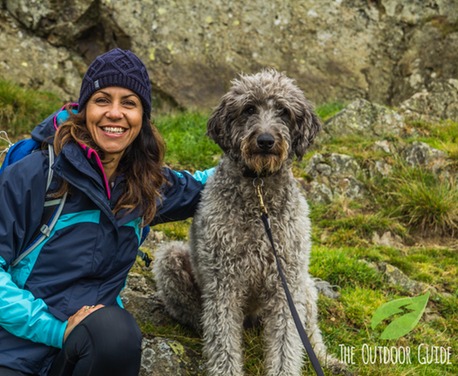What makes a good dog walk?
This summer please don’t take the risk and leave your dog alone in a car. ‘Not long’ is too long. Happy Walking!
Madog Dog Walks Group is a social dog-walking group which aims to provide regular dog walks each of just a few miles, at a relaxed pace, throughout the year. Walks are in Snowdonia and along the Cambrian Coast.
In the last 18 months, Madog Dog Walks Group have led over 100 dog-walks. We’ve had all sorts and shapes and sizes of dog and their humans! We’ve covered all sorts of terrains, we’ve all learnt a lot and shared a lot too.
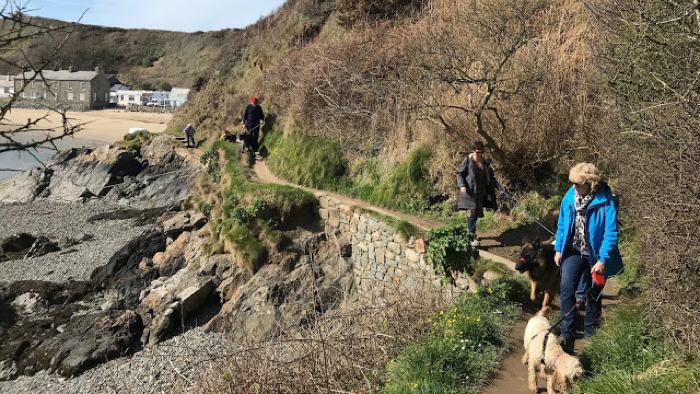
Before we schedule a group dog-walk, a leader always goes out in advance and reconnoiters the route, as close as possible to the date of the event. This is so that we know clearly what to expect, and can describe it in a way such that prospective participants can decide themselves if it’s suitable for themselves and for their dogs. It’s often difficult to determine this from published walking guides, so many of which are written without dog-walkers in mind.
Here are some of the things that we look out for, to make a good dog-walk great:
Variety and focus
We believe that a good dog walk has plenty of variety along the route, and some sort of focus. It’s not just about doing the distance, but it helps if there’s something to aim for. It may be a good halfway point for a picnic, a paddle, a rest, a change of pace, a different activity – something that breaks the walk up a bit, or gives an extra sense of purpose and achievement.
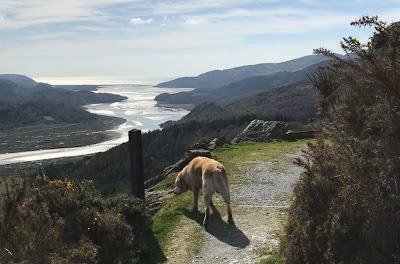
Place and pace
“Are we there yet?” Many dogs will just go and go and go, but most of us humans do need to punctuate a walk with a break here and there. It’s handy to have a snack or two in your backpack and of course a reusable water bottle!
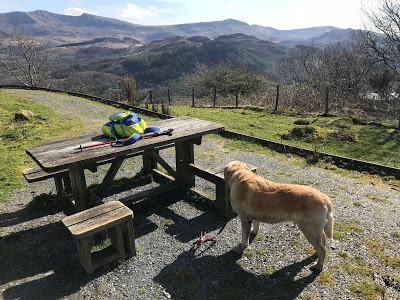
Coping with stiles and other obstacles
Not all dogs are equally agile, and nor are their accompanying humans! Encountering a difficult stile a long distance into a dog-walk can be very disheartening. Some of the simplest stiles, for humans, can challenge the confidence of the most surprising dogs too.
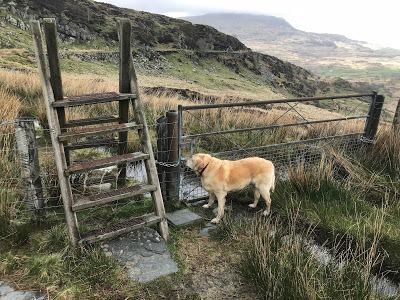
We soon discovered that getting a greyhound over a ladder-stile or through a hole in a fence is a bit like pushing a giraffe through a cat-flap. Stiles just aren’t in the greyhound repertoire. Archie tells us that he’s convinced that his legs are for running, and not for climbing. It’s taken a lot of patience, practice and ingenuity to get there, but we have done.
JJ is a hefty old labrador. He’s got the idea of going up, but usually needs a helping hand behind. At 35 kilos, he’s way too heavy to lift.
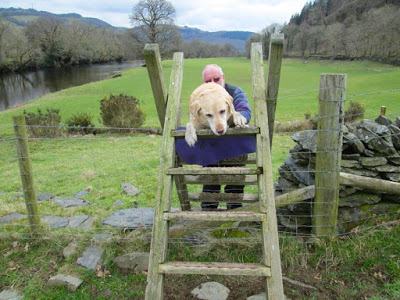
Sometimes it takes a bit of ingenuity to make a stile look less challenging for a dog. Draping a coat over the wire can avoid getting legs caught in the mesh, and make it clearer to the dog which part of the stile to tackle.
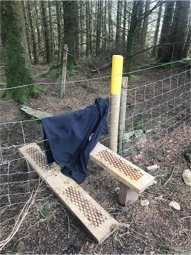
Some of the most daunting stiles, especially for large, heavy dogs, are the stone-stepped ladders over dry-stone walls. It’s usually the big gaps between the stones that seem particularly worrisome.
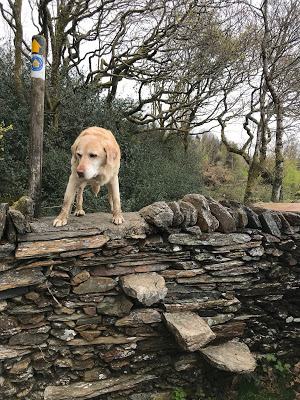
Once we’ve reconnoitered a potential walk, we often re-consider the direction or the route, to allow for stiles with awkward approaches.
Anticipating and avoiding livestock
Being sufficiently aware to have dogs on leads and under close control well in advance of any possible encounter with livestock is absolutely crucial to a safe and stress-free dog walk. It’s desirable but not always possible to plan walks which completely avoid livestock, and it’s always best to be alert for the odd un-anticipated encounter. Our group tries to schedule routes which avoid the lowland sheep pastures particularly around and after lambing time, and our prior route-reconnoiters help us to make sensible route choices.
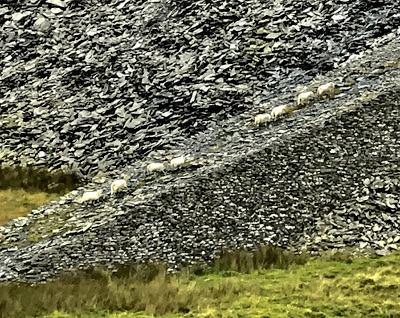
Sheep are very capable of turning up in the most unexpected of places, and feral goats even more so! So do keep your dog under close and careful control and always have a watchful eye for the unexpected.
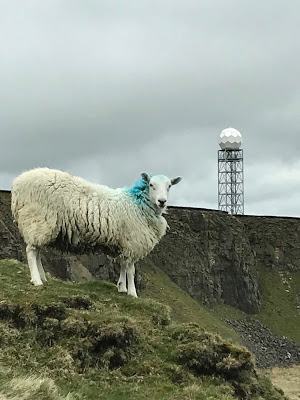
Staying safe from traffic
Many public footpaths in rural areas start from points that can be difficult to access, sometimes on busy roads without suitable nearby parking. The route too may cross busy A-roads, or even involve a short walk alongside busy traffic. Knowing about such hazards in advance and where possible how to avoid them makes a great difference to choosing a good walk and getting safely to and from the walk route.
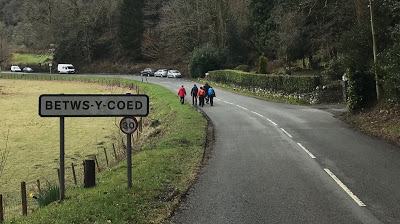
Going by public transport can be a great way, too, of doing a one-way dog-walk and getting back to the starting point easily, safely, and in comfort. Here in North Wales we regularly use the Cambrian Coast line to give easy access to some great beach walks, the Conwy Valley line to get to some great hill walks, and the TrawsCymru T2 and T3 bus services to reach locations in various parts of Snowdonia. They’re all very dog-friendly.
Dogs are also welcome on the various heritage steam railways. These too are really handy for getting between excellent dog-walking locations. JJ the Labrador is even a dog-member of the Ffestiniog Railway, which he uses regularly to reach the forestry walks in Tan-y-Bwlch or walks in the slate landscape around Tanygrisiau.
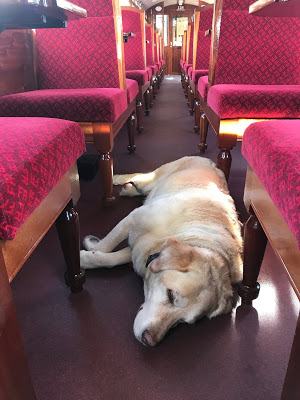
Enjoying wildlife, (safely and responsibly)
Part of the joy of dog-walking in the countryside is not just as exercise for the dog, but for the dog-walker too, to experience the tranquility and variety of the natural environment. Even so, as dog-walkers we have a duty to take care and behave responsibly there – to respect our wild places, and look after the safety of its occupants, and also of our dogs.
Adders, for example, love to bask in warm sunny spots in the summer, so may be encountered unexpectedly when walking on heathland. They are the only venomous snake in Britain, and fortunately, adder bites are fairly rare. Here in Snowdonia, we wisely take extra care when walking our dogs in locations such as Gwaith Powdwr and Garn Boduan, for example, where adders are occasionally found basking on warm summer days.
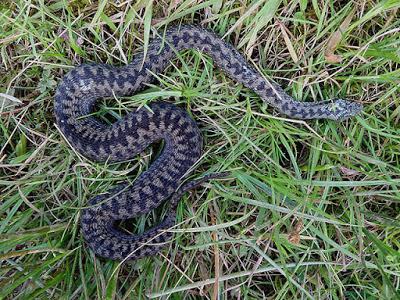
A favourite local dog walk along the Menai Straits is along the Wales Coastal Path which runs though the Vaynol Estate and Treborth Botanical Gardens. This area is gradually being re-colonised by Red Squirrels, and the landowners are hugely concerned to avoid them being chased and injured by off-leash dogs.
We do have some great dog-walking routes in some fascinating places, but we only deserve such access so long as we and our dogs enjoy them responsibly.
Consensus
A good walk has something fulfilling for every participant, dog or human. We’re all on this walk together!
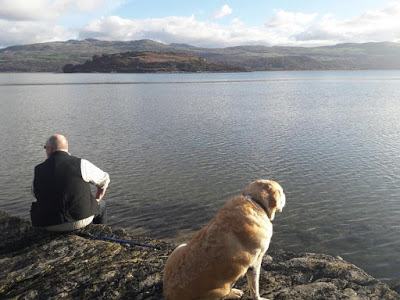
Read more: www.madogwalksgroup.org.uk/what-makes-good-dog-walk
Book a walk: https://www.madogwalksgroup.org.uk
View some great dog walks: https://theoutdoorguide.co.uk/walks/dog-friendly-walks/



